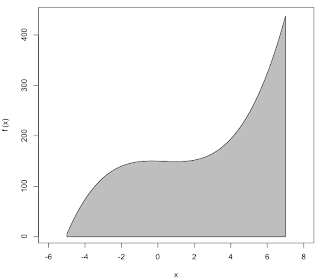
The integral calculus (the second part) allows us to easily calculate the area under this curve (between the curve and the x-axis), as shown in gray.
Remember what we said before: the relationship between the function which we plot as a curve, and its slope at any point is found by differentiating f(x) to f '(x). The slope is f '(x). The secret of integral calculus (don't tell anybody) is that the same relationship holds between the area under a curve, and the curve itself, but in reverse. That is, if the curve is f '(x), the area is f(x). It's that simple.
If we know f '(x), how do we find f(x)? Sometimes it's easy and sometimes it's hard. Suppose that every time we have a function f(x) and we find f '(x), we write the result down and save it in our little black book. When we encounter a function in an integration problem, we look in the book.
For the example, we need a function f(x), which when differentiated gives:
We look in our book, and there it is:
Of course, the area depends on which endpoints we choose. (Looking at the figure should make this clear). So evaluate the integrated function between the limits x = 7 and x = -5. We have:
I get:
I'm too lazy to finish it. But I'll check the method itself by an interesting approach in the next post.
Why do I say it's a miracle? Because we get the area from the integrated equation just by using the endpoints. We don't have to worry about what lies between. That is amazing.